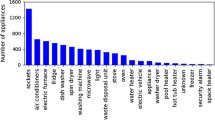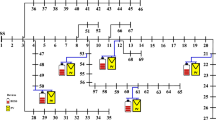Abstract
For the last 7 years, the Republic of Croatia has been witnessing a sudden increase of distributed energy resources connecting to its power system. However, a significant problem is how to find the financial equilibrium which will satisfy the independent power producers on one side and the distribution system operator on the other. In this paper, the authors discuss the capital budgeting analysis of distributed generation projects with a goal of maximizing their net present values. The evaluation of net present values will be the central tool for finding the optimal position and size of distributed generation units in the network. By simultaneously minimizing active power losses the interests of distribution system operator will not be neglected in this study. The power production of distributed generation and power consumption of network loads will be modeled with characteristic average daily power curves with discrete hour intervals. The problem will be solved using genetic algorithm, and realized in Matlab programming environment.















Similar content being viewed by others
Notes
In general, a Company’s assets are financed by either debt or equity. WACC is the average of the costs of these sources of financing, each of which is weighted by its respective use in the given situation. WACC represents how much interest the Company has to pay for every dollar it finances.
The planner can acquire the above-mentioned measurements via the SCADA (supervisory control and data acquisition) system.
That is because a chromosome containing at least one DG project with NPV\(<\)0 , may have a total NPV sum greater than the chromosome which contains all the DG projects with NPV\(>\)0. By equaling a total NPV sum to zero, the planner marks the chromosome with at least one NPV\(<\)0 as unacceptable.
The capacity factor is the ratio of the net electricity generated, for the time considered, to the energy that could have been generated at continuous full-power operation during the same period.
References
Ackermann T, Andersson G, Söder L (2001) Distributed generation: a definition. Electr Power Syst Res 57:195–204
Amanifar O, Hamedani Golshan ME (2011) Optimal distributed generation placement and sizing for loss and THD reduction and voltage profile improvement in distribution systems using particle swarm optimization and sensitivity analysis. Int J Tech Phys Probl Eng 3:47–53
Moeini A, Darabi A, Yassami H, Sadeghi MH (2010) Optimal DG allocation in distribution network using strength Pareto multi-objective optimization approach. Int J Tech Phys Probl Eng 2:47–53
Kotb MF, Shebl KM, El Khazendar M, El Husseiny A (2010) Genetic algorithm for optimum siting and sizing of distributed generation. In: Proceedings of the 14th international middle east power systems conference, Cairo, Egypt, 19–21 Dec 2010
Farashbashi-Astaneh SM, Dastfan A (2010) Optimal placement and sizing of DG for loss reduction, voltage profile improvement and voltage sag mitigation. In: Proceedings of international conference on renewable energies and power quality, Granada, Spain, 23–25 Mar 2010
Prenc R, Komen V, Bogunović N (2012) GIS-based determination of optimal accommodation of embedded generation on the MV network. Int J Commun Antenna Propag 2:91–101
Prenc R, Škrlec D, Komen V (2013) Optimal PV system placement in a distribution network on the basis of daily power consumption and production fluctuation. In: Proceedings of IEEE Region 8 EuroCon 2013 conference, Zagreb, Croatia, 1–4 July 2013
Ochoa LF, Padilha-Feltrin A, Harrison GP (2005) Evaluation of a multiobjective performance index for distribution systems with distributed generation. In: Proceedings of CIRED 18th international conference on electricity distribution, Turin, Italy, 6–9 June 2005
Shrivastava VK, Rahi OP, Gupta VK, Kuntal JS (2012) Optimal placement methods of distributed generation: a review. In: Proceedings of the international conference on advances in computer, electronics and electrical engineering, Bombay, India, 24–25 Mar 2012
Li R, Ma H, Wang F, Wang Y, Liu Y, Li Z (2013) Game optimization theory and application in distribution system expansion planning: including distributed generation. Energies 6:1101–1124
Ziari I, Ledwich G, Ghosh A, Platt G (2010) A new method for improving reliability and line loss in distribution networks. In: Proceedings of Australasian Universities power engineering conference, Christchurch, New Zealand, 5–8 Dec 2010
Georgilakis PS, Hatziargyriou ND (2013) Optimal distributed generation placement in power distribution networks: models, methods, and future research. IEEE Trans Power Syst 28:3420–3428
Sunny S, Balaji P (2013) The better optimization technique for the placement of DG in order to reduce overall cost of power system. Int J Eng Adv Technol 2:159–162
Hejazi HA, Araghi AR, Vahidi B, Hosseinian SH, Abedi M, Mohsenian-Rad H (2013) Independent distributed generation planning to profit both utility and DG investors. IEEE Trans Power Syst 28:1170–1178
Aref A, Davoudi M, Davoudi M (2012) Optimal placement and estimation of DG capacity in distribution network’s using genetic algorithm-based method. Indian J Sci Technol 5:2281–2286
Miri-Larimi SM, Haghifam MR, Jalilzadeh E (2012) Optimal sitting and sizing of renewable energy resources in distribution network with bi-level optimization. CIRED Workshop, Lisbon
Kulkarni SV, Khaparde SA, Agalgaonkar AP (2003) Optimal placement and penetration level assessment of distributed generation in MV distribution network. In: Proceedings of power systems 2003, distributed generation and advanced metering, Clemson, USA, 12–14 Mar 2003
Ponce-Corral C, Bludszuweit H, Domínguez-Navarro JA (2011) Probabilistic model for distributed generation expansion in distribution power network. In: Proceedings of international conference on renewable energies and power quality, Las Palmas de Gran Canaria, Spain, 13–15 April 2011
Zou K, Perera S, Muttaqi K, Agalgaonkar AP (2008) Optimisation of distributed generation units and shunt capacitors for economic operation of distribution systems. In: Proceedings of Australasian Universities power engineering conference, Sydney, Australia, 14–17 Dec 2008
Ahmadigorji M, Abbaspour A, Rajabi-Ghahnavieh A, Fotuhi-Firuzabad M (2009) Optimal DG placement in distribution systems using cost/worth analysis. World Acad Sci Eng Technol 25:746–753
Yassami H, Moeini A, Rafiei SMR, Darabi A, Bagheri A (2011) Optimal distributed generation planning considering reliability, cost of energy and power loss. Sci Res Essays 6:1963–1976
Falaghi H, Haghifam MR (2007) ACO based algorithm for distributed generation sources allocation and sizing in distribution systems. In: Proceedings of IEEE power technologies. IEEE, Lausanne, pp 555–560
Akorede MF, Hizam H, Aris I, Ab Kadir MZA (2011) Effective method for optimal allocation of distributed generation units in meshed electric power systems. IET Gener Transm Distrib 5:276–287
Prenc R, Škrlec D, Komen V (2013) A novel load flow algorithm for radial distribution networks with dispersed generation. Tehnički vjesnik - Technical Gazette 20:969–977
http://en.openei.org/apps/TCDB/. Accessed 5 Jan 2014
http://www.hera.hr/hrvatski/html/tarifni.html. Accessed 17 Feb 2014
Author information
Authors and Affiliations
Corresponding author
Rights and permissions
About this article
Cite this article
Prenc, R., Škrlec, D. & Đurović, M.Ž. The implementation of capital budgeting analysis for distributed generation allocation problems. Electr Eng 97, 225–238 (2015). https://doi.org/10.1007/s00202-015-0330-9
Received:
Accepted:
Published:
Issue Date:
DOI: https://doi.org/10.1007/s00202-015-0330-9




